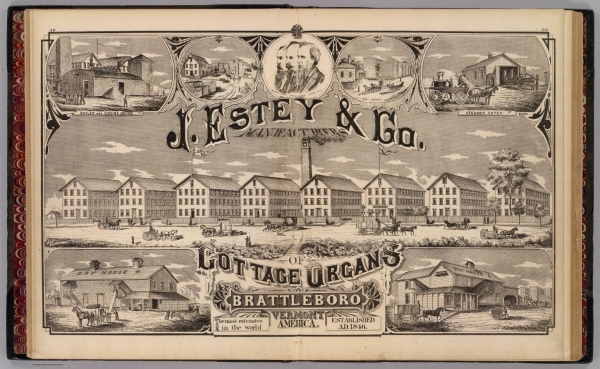BRATTLEBORO — Visitors to town often ask, “What are those huge, old, buildings covered with slate on Birge Street?”
Those familiar with local history know that these longstanding structures, considered to be the largest group of slate-sheathed buildings in the United States, were once owned by the Estey Organ Company.
At one point, the company was one of the world's largest organ manufacturers, employing more than 700 employees and craftspeople. Each organ they created proclaimed in fine black print that it was made in Brattleboro, Vermont.
From the young men, smeared with coal dust, shoveling fuel into huge furnaces to keep the machines whirling, to the immigrants from Holland, Sweden, and other countries who were invited to work in the factories because of their special crafting skills, to the women working in the office (something quite unusual during this time period), to the locals who built their homes in the part of town still known as Esteyville, there is no question that the founder Jacob Estey and his family, made a significant and lasting contribution not only to Brattleboro, but to the world.
Jacob Estey ran away from an orphanage in Massachusetts and later became an apprentice to a plumber at a tender age, then years later, took a spontaneous turn of occupation when he bought an interest in a small company making the melodeon, a type of button accordion. Within 20 years, his business would become the largest manufacturer of organs in the world.
With the advent of rail service in Brattleboro, any location on the globe could purchase organs. And purchase they did.
According to Estey Organ Company's carefully kept statistics, in the 109 years between 1846 and 1955, employees created between 500,000 and 525,000 organs. These pieces of musical art, fashioned from black walnut and oak, ivory or mother-of-pearl keys and supple leather bellows, were shipped to customers on every continent except Antarctica and as far away as New Zealand and Australia.
After a couple of fires at his factories, Estey built his slate covered factory buildings on Birge Street in 1870. At its busiest, it took 20 buildings, many of which were interconnected with covered walkways, to run his company, and manufacture all those pipe, reed and, eventually, electronic musical instruments, until 1960, when the business shut down.
More than 152 years later, those rugged, durable buildings still stand. In the remnants of the old Engine house where those coal-powered engines moved belts and pullies, sits the Estey Organ Museum, now celebrating its 20th anniversary.
In 1990, 30 years after the Estey Organ Company closed its doors, Barbara George purchased building number 6, the manufacturing firm's former offices.
A history major in college, George, now the office manager and bookkeeper for the Estey Organ Museum, says, “I didn't have a plan to own any more buildings than that one, but I did want to see the other buildings preserved.”
According to a museum newsletter article from 2004, in 1993, “thanks to the owners being willing to help with financing, she acquired building numbers 7 and 8, which had a hole in the roof and rotten foundations. The next year she bought number 5, half of which had been destroyed in a fire.”
